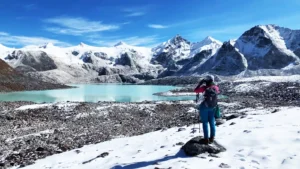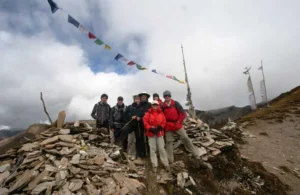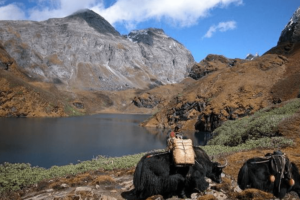Trekking in Bhutan :
Bhutan, nestled in the Himalayas, offers some of the world’s most breathtaking trekking experiences. From short cultural hikes to challenging high-altitude expeditions, Bhutan’s trekking routes traverse pristine forests, alpine meadows, remote villages, and sacred monasteries.
TOP 5 TREKS IN BHUTAN
1.Jomolhari trek

The Jomolhari Trek is one of Bhutan’s most spectacular high-altitude treks, offering a blend of adventure, culture, and breathtaking landscapes. The route spans 7 to 11 days over 82 km (50 miles), with altitudes reaching nearly 5,000m. Beginning near Paro, the trail winds through dense forests, alpine meadows, and remote highland villages, culminating at Jangothang Base Camp (4,040m) with stunning views of Mount Jomolhari (7,326m).
Trekkers cross Nyile La Pass (4,890m), visit the ancient Lingshi Dzong, and interact with yak herders who preserve Bhutan’s timeless traditions. The journey is a spiritual experience, with fluttering prayer flags and meditation caves along the way. Wildlife sightings include blue sheep, Himalayan monals, and marmots.
The best seasons for trekking are spring (April – June) and autumn (September – November), offering clear skies and vibrant landscapes.
More than a trek, Jomolhari is an immersion into Bhutan’s pristine wilderness and spiritual heart, making it an unforgettable Himalayan adventure.
2. The Legendary Snowman Trek: Bhutan’s Ultimate High-Altitude Odyssey

The Snowman Trek is one of the toughest and most rewarding treks on Earth, spanning over 300 km in 25 days through Bhutan’s most remote landscapes. With altitudes exceeding 5,000 meters, only a few trekkers complete it annually due to extreme terrain and unpredictable weather.
Starting in Paro and ending in Bumthang, the trek crosses 11 high passes, weaving through alpine meadows, ancient monasteries, and secluded valleys. A key highlight is Wangchuck Centennial National Park, home to snow leopards, Himalayan black bears, and takins. Trekkers also experience authentic Bhutanese culture in remote villages, where yak herders and monks maintain ancient traditions.
The trek demands superior fitness, acclimatization, and endurance, with brutal altitude gains and harsh weather conditions, including sudden snowstorms. The best seasons are spring (April–June) and autumn (September–October). Permits and licensed guides are mandatory, ensuring safety and environmental sustainability.
More than just a trek, the Snowman Trek is a test of endurance, a spiritual journey, and a rare Himalayan adventure. For those who conquer it, the reward is an unparalleled experience in Bhutan’s breathtaking wilderness.
3.Druk path travel.

The Druk Path Trek is a scenic six-day journey in Bhutan, covering 55 km between Paro and Thimphu. This moderate trek reaches elevations up to 4,200 meters, offering a blend of lush forests, alpine lakes, and historic monasteries.
Breathtaking Landscapes – Trek through blue pine and rhododendron forests, passing pristine lakes like Jimilang Tsho and Simkotra Tsho, known for their trout populations.
Cultural Landmarks Explore ancient sites like Jili Dzong, a 16th-century monastery with panoramic valley views, and Phajoding Monastery near Thimphu.
Himalayan Views On clear days, enjoy stunning sights of Jomolhari and Gangkar Puensum, Bhutan’s highest peaks.
4.DAGALA THOUSAND LAKES TREK

The Dagala Thousand Lakes Trek is a six-day adventure through Bhutan’s pristine alpine landscapes, offering breathtaking views of snow-capped peaks, crystal-clear lakes, and traditional villages. Starting from Thimphu, the trek ascends through dense forests and rugged terrain, reaching altitudes of up to 4,500 meters. The route is famed for its high-altitude lakes, which reflect the towering Himalayan giants, including Mount Everest, Kanchenjunga, Jomolhari, and Jichu Drake. Trekkers pass through remote Bhutanese villages, providing insight into the country’s rich cultural heritage and traditional way of life. The journey includes stops at scenic campsites like Labatama and Panka, where travelers can enjoy the solitude of nature and explore multiple glacial lakes. Spring (March–May) and autumn (September–November) are the best times to embark on this trek, offering clear skies and vibrant landscapes. While moderately challenging, the trek requires good physical fitness and acclimatization due to the high altitude. Overnight stays are in tents at designated campsites, with basic facilities. With its mix of breathtaking scenery, cultural encounters, and challenging terrain, the Dagala Thousand Lakes Trek is perfect for those seeking an off-the-beaten-path experience in Bhutan’s untouched wilderness.
5.BHUMTHANG OWL TREK

The Bumthang Owl Trek is a three-day adventure through Bhutan’s central highlands, offering a mix of cultural immersion and breathtaking landscapes. Beginning at Menchugang and ending at Jakar Dzong, the trek covers elevations between 2,250 and 3,600 meters, passing through diverse terrains. Trekkers journey through lush forests of blue pine, juniper, bamboo, and rhododendron, with panoramic views of the Himalayas, including the sacred Mount Gangkar Puensum. The route winds through traditional villages like Dhur, home to nomadic Kheps and Brokpas, allowing trekkers to witness Bhutanese customs and visit ancient monasteries. Rich in biodiversity, the trek offers chances to spot rare birds like the Himalayan Tragopan. The itinerary includes trekking from Menchugang to Dhur Village on day one, ascending to Drangela Pass at 3,600 meters on day two, and descending to Jakar Dzong on the final day. The best seasons for this trek are spring (March-May) and autumn (September-November) when the weather is stable and the landscapes are vibrant. Although moderately challenging, proper acclimatization is essential. Overnight stays are in tents at designated campsites. This trek is a perfect blend of nature, culture, and solitude, making it an unforgettable journey into Bhutan’s unspoiled wilderness.
BEST TIME TO DO THE TREKKING IN BHUTAN
The best time for trekking in Bhutan depends on weather conditions, visibility, and trail accessibility. The optimal seasons are spring (March-May) and autumn (September-November) when the weather is most stable, and the landscapes are at their most beautiful.
Spring (March – May)
• Pleasant temperatures, lush greenery, and rhododendron forests in full bloom.
• Best treks: Druk Path Trek, Bumthang Owl Trek, Dagala Thousand Lakes Trek, and Jomolhari Trek offer stunning floral displays and clear mountain views.
• Weather: Moderate temperatures in valleys, cool but comfortable at high altitudes.
Autumn (September – November)
• Best treks: Jomolhari Trek, Snowman Trek, Laya-Gasa Trek, and Bumthang Owl Trek offer spectacular Himalayan panoramas.
• Weather: Cool and crisp, with minimal rainfall, making high-altitude treks more accessible.
Other Seasons:
• Winter (December – February): Cold but good for lower-altitude treks like the Samtegang Winter Trek and cultural tours. Snow can block high passes.
• Summer/Monsoon (June – August): Heavy rains make trails muddy and slippery, but some treks in central and eastern Bhutan are still feasible.
For high-altitude treks like the Snowman Trek, autumn is the best choice due to stable conditions.

